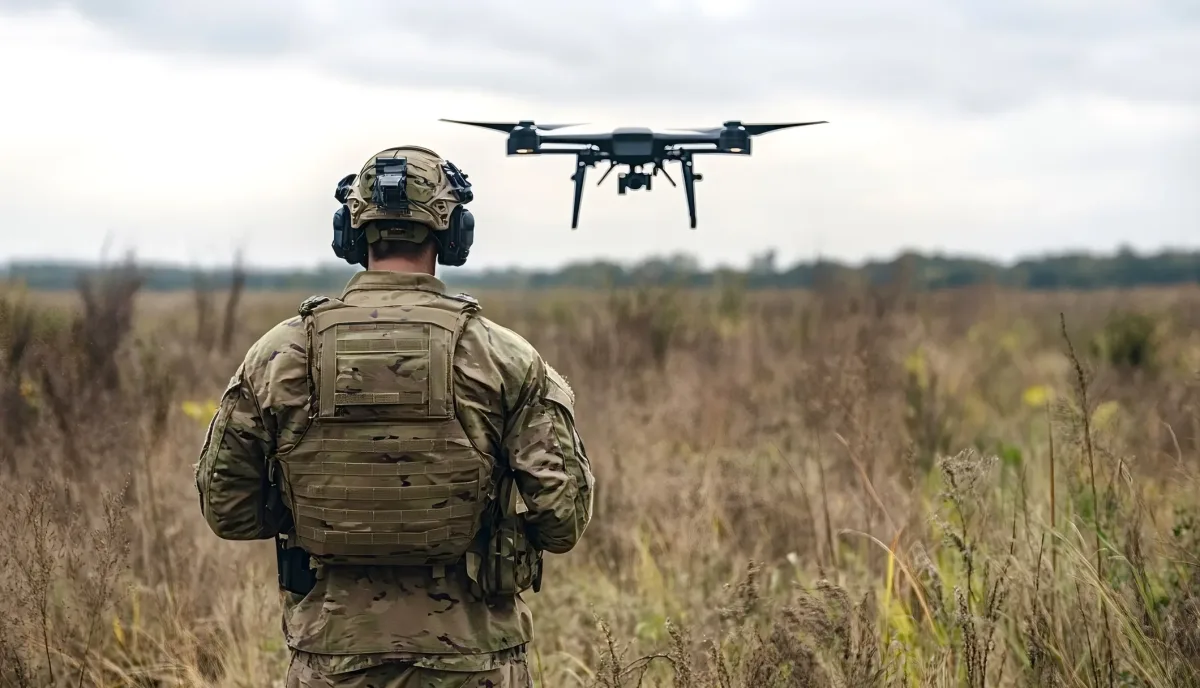When Russian tanks first rumbled across Ukraine’s borders in February 2022, few expected the war’s most devastating weapon to be a quadcopter that could fit in a shoebox.
Three years on, however, the skies above Ukraine thrum with millions of unmanned aircraft that have fundamentally altered the calculus of modern warfare. This is no longer a conflict of artillery barrages and tank columns, but a swarm-versus-swarm battle that has forced both sides to reimagine how wars are fought—and how they might be fought elsewhere.
Ukraine produced around 800,000 drones in 2023, scaling to two million in 2024, and now targets five million for 2025. Russia is reportedly matching this pace of production. To put this in perspective, America’s entire annual missile production runs in the thousands. Ukrainian drones accounted for over 96 per cent of all unmanned aerial vehicles used by the military in 2024, a domestic manufacturing achievement that would have seemed impossible just a couple of years ago.
This transition from imported Turkish Bayraktars—which inspired Ukrainian songs in 2022—to mass-produced domestic quadcopters reflects warfare’s brutal demand for adaptation.
The impressively fast innovation circles—from cardboard drones and tethered drones to increased autonomy and the use of AI—is therefore not just a result of the ingenuity of Ukrainian, Russian, and Western engineers. They are an imperative to avoid defeat.
The mathematics of destruction
The economics are as compelling as they are grim. The cost of a conventional 155mm artillery shell that is less accurate than an FPV drone and requires a multi-million-dollar howitzer to fire it is, according to open-source reports, about 3,000 US dollars. A high-end anti-tank guided missile able to home in on the thin top armour of turret, like the US-manufactured Javelin, is around 80,000 US dollars for the missile and 200,000 US dollars for the launcher.
Meanwhile, Russia’s cost per drone has fallen from 200,000 US dollars in 2022 to approximately 70,000 US dollars in 2025, due to large-scale production, though some estimates suggest Shahed-type drones cost as little as 35,000 US dollars each.
This economic logic has created what analysts call ‘cruel attritional mathematics’. Even though Shahed’s only hit their target less than 10 per cent of the time, their low cost means Russia can fire mass salvos almost daily, wearing down Ukrainian air defences. When intercepting each drone costs more than three million US dollars in surface-to-air missiles, the defender faces an unsustainable equation.
Russia has embraced this arithmetic wholeheartedly. Through July, Russia launched a record 6,443 drones and missiles into the country, according to data published by the Ukrainian air force. The total is the highest of the war to date, and around 13 per cent more than were recorded in June. Russia is moving toward producing more than 6,000 Shahed-type drones each month at its facility in Tatarstan, 500 miles east of Moscow.
Cities under siege
For Ukraine’s civilian population, this drone revolution has meant a return to bomb shelters. “Right now, Ukraine sees around 300 to 400 drones attacking civilian targets every day—these types of numbers were unheard of in 2023 or 2024,” said Yuriy Boyechko, founder and CEO of the Hope for Ukraine charity, last month. The nightly ritual of air-raid sirens has become so routine that many Ukrainians speak of ‘drone weather’—conditions that favour low-flying attack aircraft.
Russian tactics have grown increasingly sophisticated. More recently, Geran variants painted black with special material to hide from radar fly higher and with tortuous routes to evade Ukrainian defence teams. The psychological impact is as calculated as the physical damage. Every night, these systems cause millions of Ukrainians to head to bomb shelters and mobile air defence crews and electronic warfare teams to move into position.
The city of Kherson offers a grim preview of urban warfare’s future. Residents describe daily harassment by small first-person-view (FPV) drones that hunt individual targets with horrifying precision. No target seems too small: pedestrians, cars, buses, and even ambulances have been struck. This microscopic terror represents warfare’s ultimate atomisation—conflict reduced to individual hunter-killer pairs, predator and prey.
The frontline transformed
The battlefield itself has been equally reinvented. Captured soldiers claim they haven’t seen enemy soldiers at all on the front line—warfare now mediated entirely through screens and remote operators. Depending on the individual Ukrainian combat unit’s statistics, currently, between one-half and two-thirds of all Russian personnel losses and destroyed combat vehicles are drone-caused.
Ukraine has sought to establish a 15-kilometre kill zone patrolled by drones along the front lines of the conflict, making it extremely challenging to concentrate troops for major offensive operations. This ‘drone wall’ represents perhaps the most significant tactical innovation since the machine gun. Traditional military doctrine, which assumes forces can mass for breakthrough operations, confronts the reality that any concentration becomes immediately visible and vulnerable to swarming attacks.
The innovation cycle moves at blistering speed. Both Russia and Ukraine are turning to fiber optic drones that are not susceptible to jamming technologies. When electronic warfare neutralises radio-controlled systems, engineers respond with tethered alternatives. When air defences adapt to conventional attack patterns, drone operators develop new tactics. The war has become a vast laboratory for autonomous weapons development, with soldiers as both researchers and test subjects.
Production panic
This demand has triggered a manufacturing scramble that extends far beyond Ukraine’s borders. The country has had to build an entire aerospace industry from scratch while under bombardment. The government, military, private companies and regular citizens are all involved. Kitchen-table assembly lines have become a feature of urban warfare, with software developers spending evenings building FPV drones at home.
The biggest barrier to expansion, though, is money. Ukraine’s government and private sector are producing more drones than the state can afford to acquire. This peculiar situation—of domestic production outstripping state procurement capacity—highlights how completely the economic logic of warfare has shifted.
Meanwhile, Russia leverages its larger industrial base and deeper pockets. Its Alabuga facility in Tatarstan represents perhaps the world’s most efficient factory for autonomous killing machines, reportedly capable of producing an estimated six thousand Shahed-136 prototypes by mid-2025. The integration of Chinese components reveals how drone production has become globalised supply-chain warfare.
NATO’s awakening
The implications extend far beyond Ukraine’s borders, as NATO discovered when nineteen Russian drones violated Polish airspace earlier this month, triggering Article 4 consultations and prompting coalition forces—including Polish F-16s, Dutch F-35s, Italian AWACS, and German Patriots—to shoot down the intruders. Polish Prime Minister Donald Tusk called it “the closest we have been to open conflict since World War II.”
The incident exposed uncomfortable truths about Western air defence doctrine. As former US Army Europe commander General Ben Hodges noted, “Using F-35s and F-22s against drones shows we are not yet prepared”. The cost asymmetry—deploying multi-million-dollar fighter aircraft against thousands-of-dollars drones—suggests NATO’s expensive air superiority may prove less decisive than assumed.
This reality has prompted urgent reassessment. Ukrainian drone warfare specialist Robert ‘Magyar’ Brovdi, who leads the country’s Unmanned Systems Forces, warned in July 2025 that NATO commanders must urgently review their air defence doctrines in order to focus on the dangers posed by swarms of Russian attack drones. NATO members, including Britain and Denmark, are now reportedly already receiving training in drone warfare from Ukrainian military instructors.
The alliance is reportedly exploring creating its own ‘drone wall’ along the eastern frontier, borrowing directly from Ukrainian tactics. “NATO will probably end up using drones on a large scale”. Not at the same scale as Russia and Ukraine, because we’ve got these massive air forces that we’ve invested in and that can strike with a lot of power very quickly – but as a complement to that,” notes Robert Tollast, a research fellow at the Royal United Services Institute.
The global implications
The Ukrainian laboratory is producing lessons with worldwide application. Taiwan is already looking into developing large numbers of cheap attack drones. Non-state actors across the globe and drug cartels are also increasingly relying on drones. The technology’s dual-use nature means that innovations developed for Ukraine’s defence will inevitably proliferate to less savoury actors.
For traditional military powers, the implications are profound. Decades of investment in expensive platforms—fighter jets, tanks, warships—confront a reality where cheap, mass-produced systems can achieve similar effects. This suggests future conflicts may favour nations with robust manufacturing capacity and innovative engineering cultures over those with merely sophisticated weapon systems.
The Pentagon is taking notice, with programmes like the Enterprise Test Vehicle—essentially a low-cost cruise missile—directly inspired by Ukrainian innovations. China, watching from across the Taiwan Strait, surely draws its own conclusions about warfare’s new arithmetic.
The flight path ahead
As Russia’s war on Ukraine enters its fourth autumn, the drone revolution shows no signs of slowing. Ukraine has developed ‘missile-drones’ like the Palianytsia and Peklo hybrids, which can act as alternatives to cruise missiles. Zelensky has said Ukraine aims to produce at least 30,000 long-range drones next year. The distinction between missiles and drones continues to blur as both sides develop increasingly sophisticated autonomous weapons.
Nevertheless, questions remain about drone warfare’s limitations. Ukraine could also just be a peak moment for drone warfare. The factors that made drones relevant in Ukraine might look different in future wars. The overall number of drones could be lower if civilian drones cannot be used—due to weather conditions or longer distances, such as in a maritime confrontation.
What seems certain is that the Ukraine conflict has shattered comfortable assumptions about twenty-first-century warfare. The buzzing reinvention begun in Ukraine’s skies has rewritten the rules of combat, created new industrial demands, and forced military planners worldwide to confront uncomfortable truths about the future of conflict. In a world where kitchen tables can become weapons factories and consumer electronics can decide battles, the very definition of military power requires urgent revision.
The revolution, it turns out, will be miniaturised.
Photo: Dreamstime.







